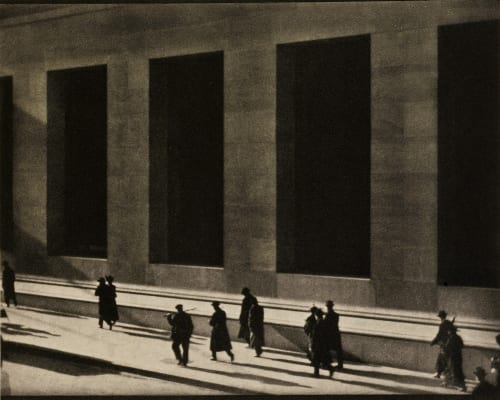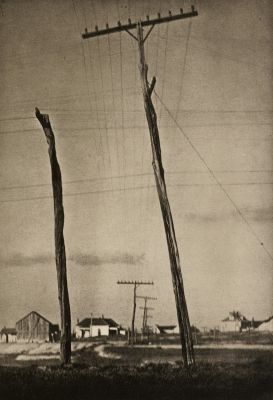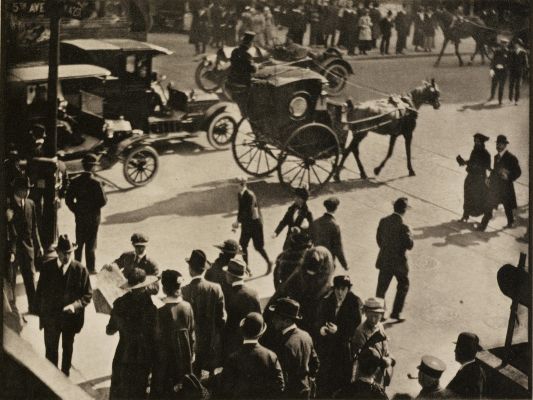
Title
New York (Wall Street)Artist
Strand, Paul (American, 1890-1976)Key FigurePublication
Camera Work XLVIIIDate
1916Process
PhotogravureAtelier
Manhattan Photogravure Company, NYImage Size
12.7 x 16.3 cm
An iconic image of Wall Street and a turning point in modern photography. Wall Street depicts a scene of everyday life in Manhattan’s Financial District. Workers are seen walking past the J.P. Morgan building in New York City on the famous Wall Street, of which the photograph takes its name. The photograph is famous for its reliance on the sharpness and contrast of the shapes and angles, created by the building and the workers, that lead to its abstraction. This photograph is considered to be one of Strand’s most famous works and an example of his change from pictorialism to straight photography. Social change was important to Strand. With Wall Street, he sought to portray a social message. He captured the faceless people next to the looming financial building in order to give a warning. Strand shows "the recently built J.P. Morgan Co. building, whose huge, dark recesses dwarf the passers-by with the imposing powers of uniformity and anonymity."[1] The people cannot escape the overwhelming power that this modern establishment will have on their future and the future of America. He warns us to not be the small people that look almost ant-like next to this building that has a massive amount of control over the American economy. The photo, now simply titled Wall Street, was one of six Paul Strand pictures Stieglitz published in Camera Work. In three of the six pictures, humanity strides out from abstract ideas, and each figure was a study in itself — an irregular item complimented by modular formats that surround it. Another set of eleven Strand photos were published in the magazine’s final issue in 1917, and those pictures, overwhelmingly endorsed by Stieglitz as ‘brutally direct’ made Strand’s reputation. [2]
Reproduced / Exhibited
Frizot, Michael. New History of Photography. Place of publication not identified: Pajerski, 1999. Print p. 332
Badger, Gerry. Collecting Photography. London: Mitchell Beazley, 1900 p. 56
Hambourg, Maria M, and Christopher Phillips. The New Vision: Photography between the World Wars : Ford Motor Company Collection at the Metropolitan Museum of Art, New York. , 1989. Print.p. 15
Roberts, Pam. Photohistorica: Landmarks in Photography : Rare Images from the Collection of the Royal Photographic Society. New York: Artisan, 2000. p. 281
Szarkowski, John. Alfred Stieglitz at Lake George. New York [NY: Museum of Modern Art New York, 1996 p. 21
Frank, Waldo D. America and Alfred Stieglitz: A Collective Portrait. New York: Aperture, 1979. pl. 103
Witkin, , London, and Shestack. The Photograph Collector’s Guide. London: Secker & Warburg, 1979. p. 105
Weaver, Mike. The Photographic Art. Edinburgh, 1986. no. 98
Homer, William I. Alfred Stieglitz and the American Avant-Guarde. Boston: New York Graphic Society, 1979. no. 122.
Doty, Robert M. Photo-secession: Photography As a Fine Art. N.Y: Eastman, 1960. plate XXXII.
Greenough, Sarah, and William C. Agee. Modern Art and America: Alfred Stieglitz and His New York Galleries; [catalog of an Exhibition Held at the National Gallery of Art, Washington, D.C., 28 January – 22 April 2001]. Washington: National Gallery of Art, 2000. no. 82.
Stange, Maren, Robert Adams, and Alan Trachtenberg. Paul Strand: Essays on His Life and Work. New York: Aperture, 1990. no. 4.
Vrba, František. Paul Strand. (Prague: State Publishing House, 1961), p. 2.
Green, Jonathan, ed. Camera Work: A Critical Anthology. (New York: Aperture, 1973), p. 316.
Tomkins, Calvin. Paul Strand: sixty years of photographs. (Millerton: Aperture, 1976), p. 144.
Margolis, Marianne Fulton, ed. Alfred Stieglitz: Camera Work: A Pictorial Guide With Reproductions of All 559 Illustrations & Plates, Fully Indexed. (New York: Dover Publications, 1978), p. 134, fig. 1 (lower left).
Roberts, Pam. Alfred Stieglitz: Camera Work: The Complete Illustrations 1903 – 1917. (Cologne: Benedict Taschen Verlag GmbH, 1997), p. 755.
Hambourg, Maria Morris. Paul Strand, circa 1916. (New York: The Metropolitan Museum of Art, 1998), p. 159, cover ill.
Llano, Rafael. Paul Strand: en el principio fue Manhattan [First there was Manhattan] (A Coruña: Fundación Pedro Barrié de la Maza, 2008), p. 61.
Daniel, Malcolm. Stieglitz, Steichen, Strand: Masterworks from the Metropolitan Museum of Art. (New York: Metropolitan Museum of Art; New Haven: Yale University Press, 2010), pl. 94.
Lindner, Christoph. Imagining New York City: Literature, Urbanism, and the Visual Arts, 1890 – 1940. (New York: Oxford University Press, 2015), fig. 33.
References
[1] Ollman, "Art Review: Paul Strand: A Transition, Caught on Film.
[2] Description from Shapero Rare Books (London, United Kingdom) website 2/23







